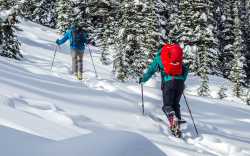>>2223521Quick avy rundown:
There are 3 types of avalanches: fresh powder, slab avalanches, and melt avalanches. Powder avalanches are easy to avoid as they only happen during heavy snowfall i.e. blizzard conditions, when you shouldn't be skiing anyway. Melt avalanches happen when snow is wet from thawing, i.e. in the afternoon in spring, so they're also easy to avoid (be down before the snow gets very slushy). Slab avalanches are what you should be worried about. They happen when a buried layer of weak snow gets disturbed (like from the weight of a skier) and collapses - imagine a big fucking concrete slab delicately balancing on dominoes, and you get the idea. When that weak layer collapses, suddenly, a huge literal slab of snow is no longer resting on anything. If the ground is flat it will just fall down by gravity, but if it's steeper than 30°, it will slide and fuck you up. Avalanche self rescue kind of works (avalanche probe + shovel + avalanche beacons for everyone in the party), but you have about 15 minutes to dig someone out before they suffocate. Better to not get caught and buried at all.
With that being said, check your local conditions, of course. Maybe your slopes aren't steep enough. Altitude does not play any role in creating weak layers, so you can't bet on that. Check if there are local avalanche forecasts in your area (the weather or ski patrol service usually have them).
For clothing, definitely go with layers. Going uphill warms you up, and insulated jackets and pants get too warm too quickly. Piste skiing clothes in general are too warm - they're made to keep you warm sitting in a lift. Layers, pants with sideways zippers, jackets with zipper vents, and lightweight stuff if you can find it. Some days will be sunny and you'll only need a technical T-shirt, others you'll have strong winds and low temps. Layers give you the flexibility.
For a backpack, again, go lightweight and get something with a good ski carry system.

